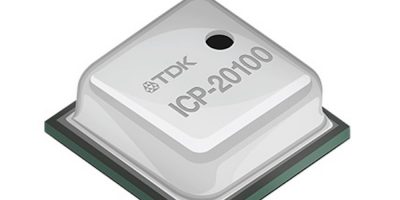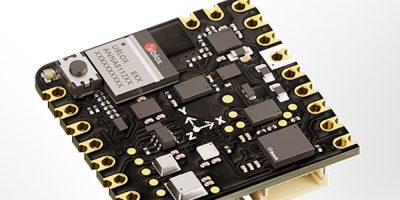Able to measure a height difference as small as 50mm, the ICP-20100 low noise MEMS barometric pressure sensors have a compact footprint for use in smartphones, tablets, drones, augmented reality / virtual reality (AR / VR) equipment and smart home appliances.
The InvenSense ICP-20100 sensors combine a barometric pressure and a temperature sensor in a 2.0 x 2.0 x 0.8mm package. The low noise pressure sensing capabilities, with a range of 30 to 110 kPa, allows the device to detect altitude changes of less than 50mm.
The performance extends InvenSense’s SmartPressure family and offers multiple input voltage levels of 1.2V, 1.8V and 3.3V. There is also a choice of interfaces, namely I²C, I3CSM and SPI. The ICP-20100 can be configured to achieve low noise or low power performance.
The SmartPressure family uses a capacitive MEMS architecture to deliver lower power consumption and lower noise than competing pressure sensors technologies, explains InvenSense. In addition to operation over a wide temperature range, the ICP-20100 pressure sensor can deliver the measurement accuracies required by applications such as 3D geolocation and emergency location service (E911), mobile indoor / outdoor navigation, sport and fitness activity tracking and altitude-hold in drones. The sensor’s low power consumption assists in extending battery life for always-on applications, for example in the IoT. The pressure sensor temperature co-efficient offset is ±0.5 Pa/ degrees C.
A development kit, the DK-20100, and evaluation platform with software are also available.
The ICP-20100 joins the existing ICP-10125, ICP-10101, and ICP-10111 pressure sensors in the SmartPressure family.
Target applications in addition to smartphones and tablets are sports, and fitness activity monitoring devices, altitude control for drones and aerial toys, gaming equipment, including virtual reality. The ICP-20100 can also be used for indoor / outdoor navigation, for example in detecting, floors in a lift or steps. In smart home appliances, they can be used in robotic vacuum cleaners and other equipment which needs sensing capabilities.
TDK was established in 1935 to commercialise ferrite, a key material in electronic and magnetic products. The company’s portfolio features passive components such as ceramic, aluminium electrolytic and film capacitors, as well as magnetics, high-frequency and piezo and protection devices. There are also sensors and sensor systems such as temperature and pressure, magnetic, and MEMS sensors, power supplies and energy devices.
Products are marketed under the product brands TDK, Epcos, InvenSense, Micronas, Tronics and TDK-Lambda. TDK focuses on demanding markets in automotive, industrial and consumer electronics, and information and communication technology. The company has a network of design and manufacturing locations and sales offices in Asia, Europe, and in North and South America.






